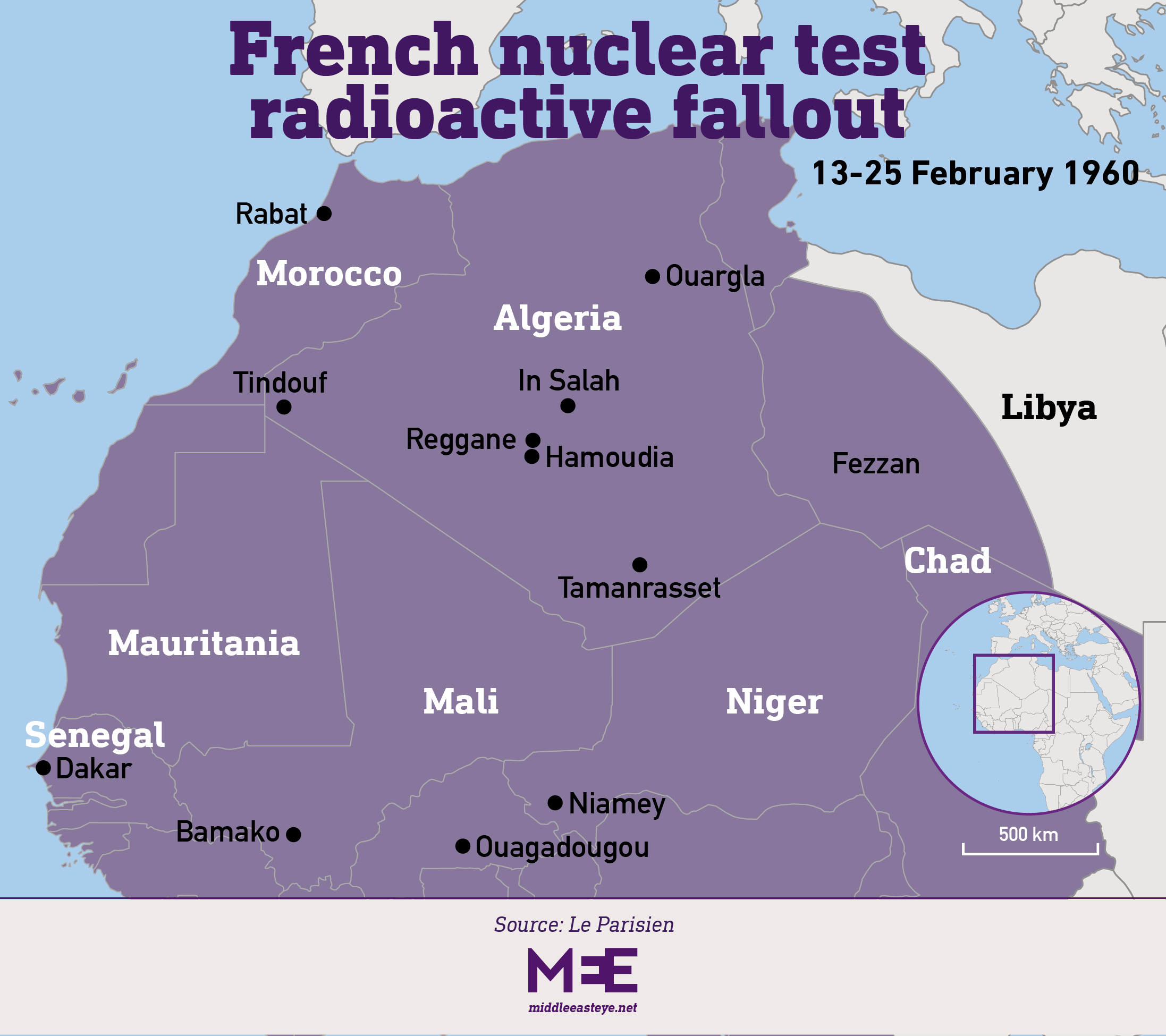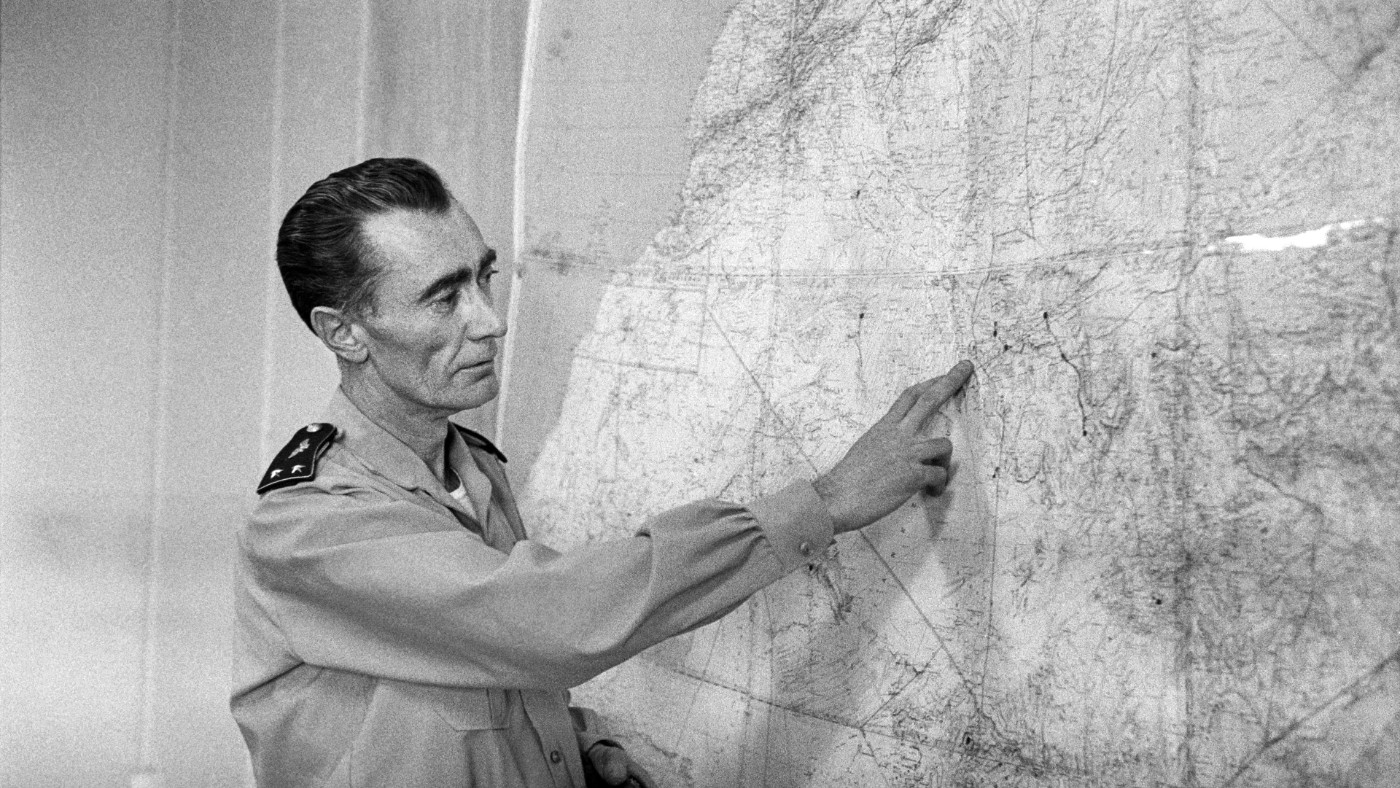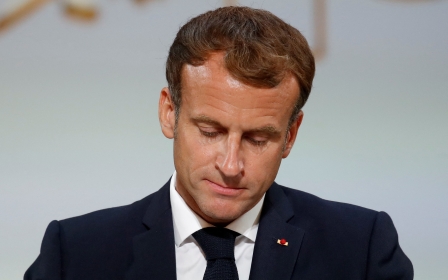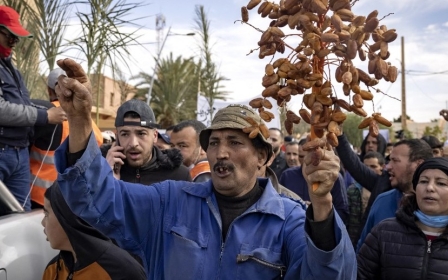'The day the desert wind cried': French nuclear tests cast long shadow in Libyan Sahara
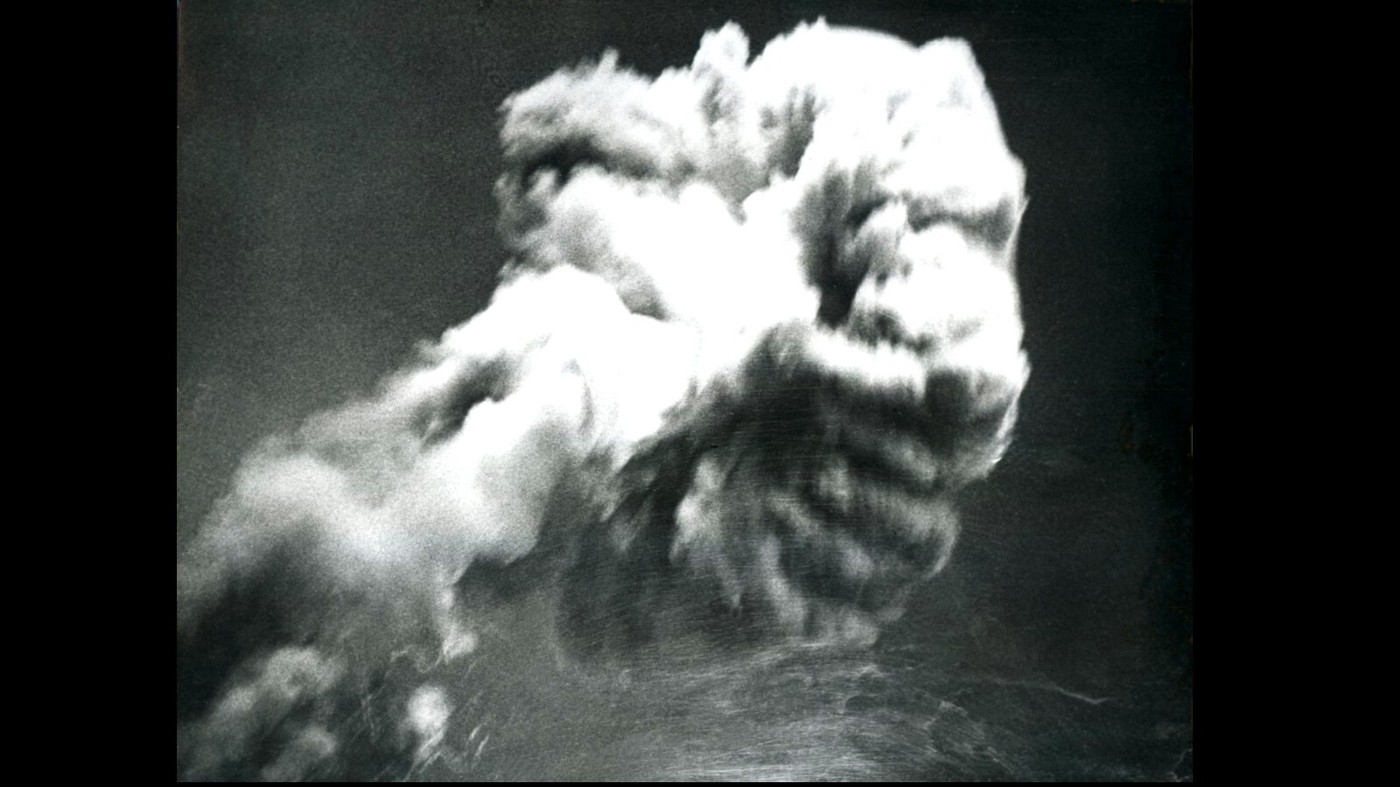
“I search for words that do not exist. My father passed away on the day the desert wind cried, and his absence is still there, like a loud mute cry, like a void that words cannot fill.”
Abed Alfitory is 64-years old now. But he still remembers his father’s death and the events that led to it.
Alfitory is from Fezzan, the largely desert region of southwestern Libya. It is here, deep in the Sahara, that he spent 20 years collecting material for his book Desert Cry, motivated by the loss of his father’s sight in 1960 and his death a few years later.
Speaking to Middle East Eye from his home in al-Zighan, the professor of philosophy at Sabha university told Middle East Eye that his childhood had come at a great cost, that he struggled amidst hard conditions and that he had been haunted by his father’s blindness.
Later, Alfitory discovered what had caused his father’s condition. He learnt, too, that he was not alone.
New MEE newsletter: Jerusalem Dispatch
Sign up to get the latest insights and analysis on Israel-Palestine, alongside Turkey Unpacked and other MEE newsletters
Many people in Fezzan had been struck down by respiratory diseases and ophthalmia in 1960. The acute eye infection was so prevalent then that it became known as the “year of ophthalmia”.
This was followed by the “year of smallpox”, the “year of the yellow wind” and the “year of gnawing”. The people of the Fezzan began to get cancer in greater numbers. Acid rain fell. The land was afflicted. What had happened?
Explosions in the Sahara
On 13 February 1960, France conducted its first nuclear test at Reggane, an oasis town in southern Algeria. The war for the North African country’s independence had been ongoing since 1954 and French President Charles de Gaulle was keen to show the world that France belonged at the top table of military powers.
To that end, the first French atomic bomb, named Gerboise Bleue after the blue of the tricolour flag and a small desert animal in the Sahara, was detonated in the Algerian desert. It released over four times the amount of energy as that of the US bomb dropped on Hiroshima.
A few months later, as Soviet leader Nikita Khrushchev was in France for an official visit, a second French bomb was detonated in the Sahara.
'Hundreds of people with cancer whose cause is unknown still appear in Fezzan'
- Mohammed Nasr, Fezzan local
Between 1960 and 1966, four years after Algeria gained its independence, France detonated 17 bombs in the Sahara, including four in the atmosphere near Reggane. Witnesses to the tests described them as the most brutal thing they’d ever seen in their lives.
Four underground explosions in the Algerian Sahara “were not totally contained or confined”, according to a French parliamentary report.
Most famous of these was the Beryl incident, during which nine soldiers and a number of local Tuareg villagers were heavily contaminated by radioactivity.
The impact of France’s nuclear testing programme in Algeria was immediate and has been ongoing.
Following the first explosion in 1960, radioactive fallout landed in newly independent Ghana and in Nigeria, which was in its last days as a British colony.
Secret defence documents cited by Le Parisien in 2014 revealed that much larger areas than had been claimed by the government had been affected.
In fact, contrary to Paris’s assertions, radiation from the first bomb alone had covered a region that ran from Algeria to Libya to Mauritania and on to Mali and Nigeria. The impact even reached as far north as Spain and Italy.
According to a French military map, the southern Libyan region – and Fezzan in particular – had been heavily impacted, with western winds blowing a nuclear cloud from test sites at In Ekker in Algeria to Fezzan.
A grain of sand retains radiation for an estimated period of 24,000 years. One of the most important demands of the people of the desert – that the area be cleared of remaining surface residue and that the places where nuclear waste is buried be uncovered – has been completely ignored by the French, locals said.
Under an orange sky
On February 2021, Saharan sands were blown from Algeria across the Mediterranean. The sky turned orange. The sand bore unusually high levels of radiation.
Back in Algeria, close to the testing sites, studies conducted over the years have found that the local population has continued to suffer from the experiments, with birth defects and serious illnesses “passed down through generations, in addition to many types of cancer”.
Between 27,000 and 60,000 Algerians were affected by the radiation levels, according to Abdul Kahdim al- Aboudi, an Algerian professor of nuclear physics at Oran University who died in 2021.
Over the border, in the Libyan Sahara, the impact of French nuclear testing has been less thoroughly documented. Researchers looking into the impact of the tests have faced obstructions of various kinds, with French, Libyan and Algerian authorities all believed to be responsible for blocking investigations.
Interviews with locals and official information provided to MEE show, though, that thousands of people in Fezzan still suffer from the French tests carried out in the 1960s.
“There is a need to research and investigate the damage that befell the people of Fezzan as a result of the tests,” Mohammed Salih, a 55-year-old teacher from the village of Wadi Atba, told MEE. Salih said 1960 was also known as the “year of surprise”, and that people and houses had been buried in its aftermath.
“The situation has lasted for a long time and has left its tract to this day,” he said. “People have been suffering.”
Saada Jibril, a 70-year-old farmer from the village of Ghaddwah, said that in 1960 acid rain fell, killing camels and “afflicting people with a fever that killed entire families”.
One of those affected was Jibril’s grandfather, who had a fever and died two days later. “I was a child, but I still remember these painful moments,” he told MEE.
“The pain continues to this day,” Mohammed Nasr, from Fezzan, told MEE. “Hundreds of people with cancer whose cause is unknown still appear in Fezzan. Not a day passes without burying the dead from cancer.”
'My father lost his sight, and this caused me great hardship. Today, the same reason has prevented me from moving. How many evils await future generations?'
- Abed Alfitory, professor of philosophy, Sabha University
Nasr spoke also about low fertility rates in successive generations following the nuclear tests. This is partly, he said, because “heavy rains are the only source of groundwater in the Fezzan due to its scarcity, and the source is the Algerian desert, which reinforces the hypothesis of buried nuclear waste”.
Research has found that the tests resulted in contamination of groundwater and the presence of radioactivity there.
The Libyan Union Against Cancer said that the number of cases in the south are high. This is especially true of lung cancer.
Omar Ali, a consultant oncologist, told MEE that while there are no accurate statistics relating to the number of people with cancer in Libya, the “number is huge”. “The reason for this is the pollution of water and air by nuclear explosions,” he said.
The impact from nuclear explosions usually comes in two stages: the first is skin diseases and allergies. The second is cancerous tumours, which many in the Libyan desert suffer from.
Cruel twist of fate
Abed Alfitory sought, in researching his book, to collect oral accounts in Fezzan, speaking particularly to the elderly and communicating with Professor al-Aboudi.
Al-Aboudi wrote of the long-term effects of the nuclear detonations, including tumours, congenital anomalies and more.
In a cruel twist of fate, Alfitory, who has done so much to document the pain of the people of the Fezzan and who saw his father killed by the nuclear tests, now suffers from a cancerous tumour.
His eyes filled with sadness as he talked to MEE about it.
“Yesterday, my father lost his sight, and this caused me great hardship. Today, the same reason has prevented me from moving. How many evils await future generations?”
In the end, Alfitory is left with thoughts of his beloved father, memories that remain. “The light that radiates from the goodness of his memory still warms the corners of my sides,” he told MEE.
“And I am still as I was before going to sleep and between dawn and dusk I close my eyes and talk to him. There are things that we can only see in the dark, and his memory still whispers in my ears, his last words while he was on his deathbed, the moment of farewell, how hard it is to lose a father.”
This article is available in French on Middle East Eye French edition.
Middle East Eye delivers independent and unrivalled coverage and analysis of the Middle East, North Africa and beyond. To learn more about republishing this content and the associated fees, please fill out this form. More about MEE can be found here.


